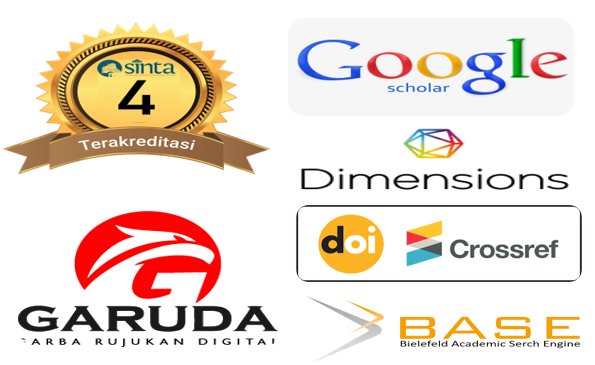Integrating websites to self access language learning: a strategic way to facilitate the autonomous learning
Abstract
Up to this present time, self access language learning (SALL) has become an interesting topic for study. Many scholars have devoted their attention to the study on this topic that many of their papers are published in Studies in Self Access Learning journal. Though many studies have discussed this topic, the websites that can be integrated into SALL as a strategic way to ficilitate the autonomous learning remains underresearched. This paper is based on a research looking at the integration of websites into SALL from the perspective of SALL materials in an online SALL centre. It looks at which English language skills are offered as SALL materials and which websites provide SALL materials. The data concerning these two themes were collected from the online visit to to Self Access Centre and INdependent Learning (SACIL) set up at the University of Waikato. SALL materials in SACIL include general language skills, grammar, reading, listening, speaking and pronunciation, writing, punctuation, vocabulary and spelling, IELTS, and study skills and exam preparation which are linked to a large number of websites. With these website-based SALL materials, the learners over the world can finally practice their skill autonomously.
Key words: website, self access laguage learning, autonomous learning.
References
Benson, P. (2001). Teaching and Researching Autonomy in Language Learning. New York, NY: Longman/Pearson Education.
Cheetham, C., Elliott, M., Harper, A., & Ito, M. (2017). Accessibility and the promotion of autonomous EFL reading. Studies in Self - Access Learning Journal, 8(1), 4-22 Retrieved from http://sisaljournal.org/archives/mar17/cheetham_et_at.
Dofs, K., Hobbs, M. (2016). Autonomous language learning in self-access spacesMoodle in action. Studies in Self-Access Learning Journal, 7(1),72-83.
Fisher, D., Hafner, C., Young, J., 2007. Integrating independent learning: Lessons learned and implications for the classroom. In: Gardner, D. (Ed.), Learner Autonomy 10: Integration and Support. Authentik, Dublin, pp. 33-55.
Gardner, D., Miller, L., 1997. A Study of Tertiary Level Self-Access Facilities in Hong Kong. Hong Kong: City University.
Gardner, D., Miller, L., 1999. Establishing Self-Access: From Theory to Practice. Cambridge: Cambridge University Press.
Gardner, D., Miller, L. (2011). Managing self-access language learningPrinciples and practice. System, 39, 78-89.
Gibbs, G. (1995). Assessing student centred courses. Oxford, UK: Oxford Centre for Staff Learning and Development.
Gremmo, M.-J. Riley, P. (1995). Autonomy, self-direction and self access in language teaching and learning: The history of an idea. System, 23, 151-164.
Holec, H. (1981). Autonomy and foreign language learning. Oxford, UK: Pergamon.
Kir, E. Kayak, S.(2013). The evaluation of websites teaching english as a foreign language (efl). ProcediaSocial and Behavioral Science, 106, 27882795.
Littlewood, W. (1991). Curriculum Design. In R. Bowers, C. J. Brumfit (Eds.), Applied Linguistics and Language Teaching (pp. 11-22). London: Macmillan The British Council.
Lynch, A. B. & Campos, J. L. A (2014). The Use of Technological Tools in the EFL Class. Revista de Lenguas Modernas, 20, 427-434.
McMurry, B, L., Tanner, M. W., & Anderson, N. J. (2010). Self-Access Centers: Maximizing Learners Access to Center Resources. Studies in Self-Access Learning Journal, 1(2), 100-114.
Morrison, B., (2008). The role of the self-access centre in the tertiary language learning process. System, 36, 123e140.
Motteram, G. (2013). The benefits of new technology in language learning. Online Magazine VOICES, 18 September. Retrieved on 13 June 2017 from HYPERLINK https://www.britishcouncil.org/voices-magazine/the-benefits-new-technology-language-learning.
Murray, D.E. & McPherson, P. (2004). Using the Web to support language learning. Sydney: National Centre for English Language Teaching and Research Macquarie University.
Papadima-Sophocleous, S. (2013). Self-Access Language Learning Programme: The case of the English Language Voluntary Intensive Catch-up Study. Studies in Self-Access Learning Journal, 4(2), 125-140.
Salvia, O. S. (2000). Integrating a self-access system in a language learning institutiona model for implementation. Links Letters 7, 95-109.
Sheerin, S. (1989). Self-access. Oxford: Oxford University Press.
Sheerin, S. (1991). Self-access. Language Teaching, 24 (3)143-157.
DOI: 10.30595/lks.v13i1.3883
Copyright (c) 2019

This work is licensed under a Creative Commons Attribution 4.0 International License.
ISSN: 2620-4037

